Battle of Ridgeway and Fort Erie.
It was several decades after the War of 1812 when the colonies in what is now Canada, once again had to fight armed invaders coming from the US .
On this date in 1866, a force of several hundred Americans calling themselves “Fenians” had crossed from the American side of the border hoping to seize and control the colony of British colonies to the north..
The Fenians were a group of Irish nationalists. In the 1860’s they were a not an inconsequential number in the US, with a small number in Canada as well.
The American group hatched a rather far-fetched plan to invade “Canada”, take control and hold it for ransom to negotiate and an exchange with England. England would get “Canada” back if in return, it would give up Ireland.
There were actually five Fenian raids or planned raids into Canada, all of which failed.
In April 1866, a force of about 700 Fenians gathered in Maine intending to seize New Brunswick’s Campobello Island.
The British Commander in Halifax, on hearing word of the group’s massing in Maine, immediately sailed with an equally large group of British regulars. When the ships and troops arrived in the area, the Fenians had second thoughts and dispersed.
On June 1st however, a second group of anywhere from 700 to about 1300 crossed the Niagara River from the US into what was then known as Canada West, now Ontario. The force consisted of many men who were battle experienced from the US Civil War, and well-armed.
The group first took over Fort Erie across from Buffalo New York, and then headed inland threatening the Welland Canal.
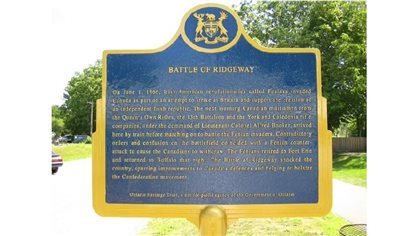
Plaque text-On June 1, 1866, Irish-American revolutionaries called Fenians invaded Canada as part of an attempt to strike at Britain and support the creation of an independent Irish republic. The next morning, Canadian militiamen from the Queen’s Own Rifles, the 13th Battalion and the York and Caledonia rifle companies, under the command of Lieutenant Colonel Alfred Booker, arrived here by train before marching on to battle the Fenian invaders. Contradictory orders and confusion on the battlefield coincided with a Fenian counterattack to cause the Canadians to withdraw. The Fenians retired to Fort Erie and returned to Buffalo that night. The Battle of Ridgeway shocked the country, spurring improvements to Canada’s defences and helping to bolster the Confederation movement
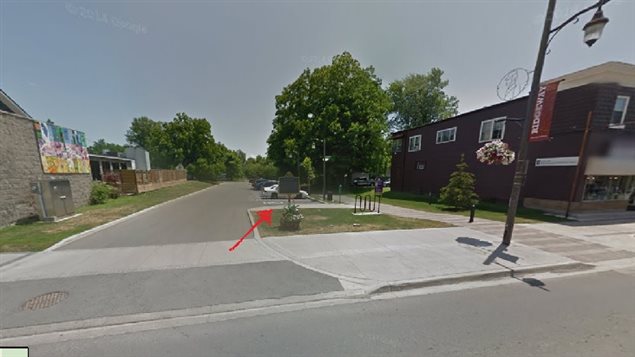
Unlike the invasion of 1812 however, there were now telegraphs and steam power. So when the word spread of the invasion, a hastily gathered force of Canadian militia sailed from Toronto, while others gathered in Hamilton and elsewhere and marched all night or arrived by train, to challenge the Americans. Although armed with good rifles, the Canadians were inexperienced volunteers, many just young boys, and were unaware they were heading into a well-laid trap.
When the two sides met on June 2nd, near Limestone Ridge (Lime Ridge), the Fenians had planned to skirmish and withdraw, enticing the Canadian forces to follow into a trap laid by the main force.
Mistakes and confusion however saved the inexperienced Canadians from a worse disaster. The Queen’s Own Rifles who had been exchanging shots with the Fenians saw the 13th Hamilton Battalion arrive with red coats and mistaking them for British regulars began to withdraw leaving the field to the “professionals”. The Hamilton group thought it was a retreat and also moved back.
The Ridgeway Nine
The Americans then charged and in the confusion, all the Canadians beat a hasty retreat to Port Colborne leaving seven dead on the field including three University of Toronto student volunteers who had left their final exams to follow their unit into battle. Two other volunteers died shortly afterward of wounds. They would become known as the Ridgeway Nine. About 90 others were wounded and several of them would die later of wounds and disease.
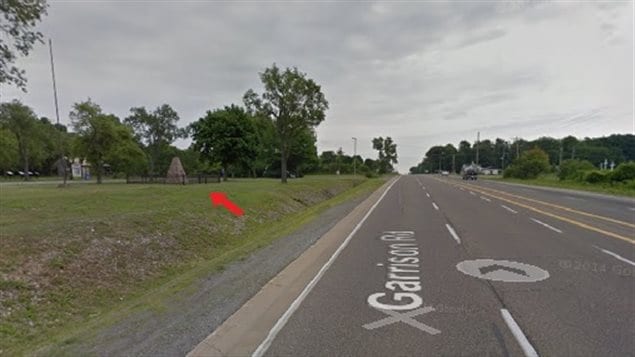
The Fenians, who had lost eight killed and over a dozen wounded, were now aware that reinforcements would be coming and so they headed back to Fort Erie.
There they were surprised to find a small force of about 70 Canadian marines and artillerymen armed only with rifles which had arrived on a steam launch. After a brief battle in the city streets on June 3, the vastly outnumbered Canadians surrendered.
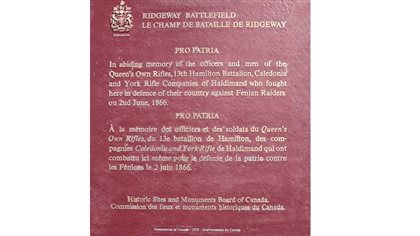
However, now the American government, embarrassed by this invasion by American citizens, and not wishing to antagonize Britain, moved to stop more Fenians from crossing the river into Canada. The Fort Erie force realizing their position, released the prisoners and crossed back to Buffalo where they surrendered.
The Americans took their weapons and ordered them back to their homes.
The battles of Ridgeway and Fort Erie were the first time that Canadians had fought on their own under Canadian leadership for their homes and not for the British Crown.
However that was not the end of the attempts. After the Canada West invasion failed, the Fenians tried at Canada East, now Quebec.

The main result of the Fenian raids- the creation of Canada
In spite of US government efforts to stop them, about 1000 Fenians marched into Canada East on June 7th with the idea to seize Pigeon Hill, Frelighsburg, St. Armand and Stanbridge. Again Canadian forces were deployed and Fenians low on ammunition and supplies quickly surrendered.
The main result of these raids was to create even more suspicion of the US, which many believed to have taken a rather lax attitude toward the Fenians and their intentions which were not particularly secret. The battle by Canadian volunteer militia also served to increase a sense of nationalism in the colonies and as such gave impetus to the movement to form the colonies into a confederation better able to defend itself, thereby hastening their union into the new country of Canada which succeeded just a year later in 1867.
Still, it wasn’t over.
In May 1870, another group againt tried to enter what was now Canada from Vermont. This became known as the Battle of Eccles Hill. Forewarned by a double agent, the Canadians quickly spotted the invaders and a battle ensued, eventually the Fenians fled leaving guns and dead behind.
In 1871, much further west, they tried again. With a tiny force of about 35, they planned to invade Manitoba and connect with the Metis who had been having their own fight with Canada.
They captured a Hudson’s Bay trading post and a customs house they thought were in Canada but turned out to be two miles inside the US and a dozen were eventually taken prisoner by the US Army.
As the Metis had just signed a deal with the Canadian government as the invasion began, they captured the other Fenians and turned them over to US authorities.
However another result of the Battles of Ridgeway/Fort Erie was discontent by participants that the battles were largely forgotten, even deliberately by the new federal government which sought to whitewash what was essentially a defeat. Twenty five years later, veterans banded together essentially in protests and on June 2, 1890 marched to a Volunteers Monument in Toronto to place wreaths and flowers.
In 1891 on what became known as “Decoration Day”, thousands showed up to march, and tens of thousands watched. Decoration Day, held on the Sunday nearest June 2 soon became a national event commemorating of Ridgeway, the North-West Rebellion, the Second Boer War, and the tens of thousands of fallen in the First World War. Decoration Day remained the day of remembrance for fallen soldiers until Parliament passed the Armistice Remembrance Day Act which established November 11 as the official day of remembrance for fallen Canadian military personnel.
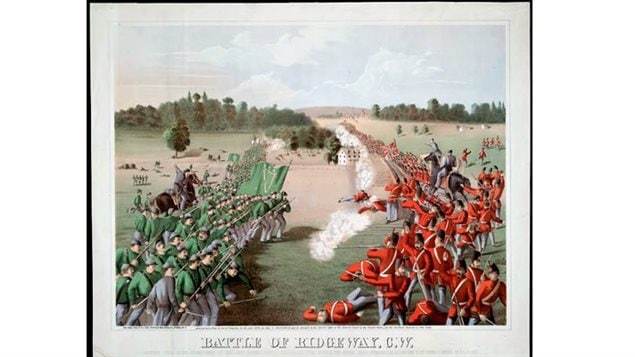






For reasons beyond our control, and for an undetermined period of time, our comment section is now closed. However, our social networks remain open to your contributions.